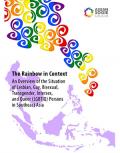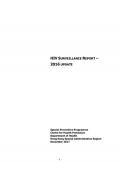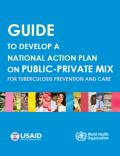What's New
Displaying results 1711 - 1720 of 4922

Resource | Publications,
Kauntim mi tu, an integrated bio-behavioural survey (IBBS) of women and girls who sell and exchange sex (from here on referred to as FSW), and men who have sex with men and transgender women (from here on referred to as MSM/TG), was conducted to support the scale-up of essential HIV prevention and treatment services for these populations. The survey was conducted in Port Moresby between June and November 2016 and used respondent-driven sampling (RDS) to recruit participants. Kauntim mi tu had two goals: 1) to conduct Papua New Guinea’s first population size estimations of FSW and MSM/TG; and 2) to collect representative bio-behavioral data about FSW and MSM/TG in order to inform HIV and STI prevention and treatment services and policy.

Resource | Publications,
This report is an account of the Region’s progress in developing and implementing NAPs. The report provides a platform to track what is going well, and to identify areas where extra efforts are needed. In the report, the regional roadmap for strengthening national AMR prevention and containment programmes is analysed with a specific methodology. The results gathered have been compiled to contribute to country profiles which make the report more useful.

Resource | Publications,
The report highlighted key human rights trends, such as the increasing criminalization and pathologization of LGBTIQ people amidst the rising influence of conservative social forces. The report likewise discusses the increasing threats against human rights defenders working on sexual orientation, gender identity and expression, and sex characteristics (SOGIESC). Moreover, persistent discrimination in accessing social services and protection is also brought to light.

Health Indicators 2017 Malaysia: Indicators for Monitoring and Evaluation of Strategy Health for All
Resource | Publications,
This is the 33 edition of the "Indicators for Monitoring and Evaluation of The Strategy Health for All" since the first Common Framework for evaluation (CFE) was carried out in 1985. The global indicators have remained unchanged ever since. These indicators represented the essential minimum for member countries of WHO to evaluate their national strategy towards HFA goals.

Resource | Publications,
The HIV surveillance system in Hong Kong comprises five main programmes to provide a detailed description of the local HIV/AIDS situation. They are (a) voluntary HIV/AIDS case-based reporting; (b) HIV prevalence surveys; (c) sexually transmitted infections (STI) caseload statistics; (d) behavioral studies; and (e) HIV-1 genotyping studies.

Resource | Publications,
UNICEF has long been at the heart of global efforts to put the HIV epidemic into an irreversible and rapid retreat. Under the Strategic Plan for 2018–2021, UNICEF will continue to align its HIV-related commitments to global goals and targets detailed in the -
- 2030 Agenda for Sustainable Development;
- the Political Declaration agreed to at the June 2016 United Nations High Level Meeting on Ending AIDS;
- the Fast Track Strategy to End AIDS developed and championed by the Joint United Nations Programme on HIV/AIDS (UNAIDS);
- the United Nations Global Strategy for Women’s, Children’s and Adolescents’ Health 2016–2030;
- the ‘Start Free, Stay Free, AIDS Free’ Framework for Ending AIDS in Children, Adolescent Girls;
- and the All In Framework to end AIDS in Adolescents and Young Women by 2020 that emerged following the success of the Global Plan Towards the Elimination of New Infections Among Children by 2015 and Keeping their Mothers Alive (Global Plan).

Resource | Fact Sheets,
As in the earlier rounds, the Ministry of Health and Family Welfare, Government of India designated International Institute for Population Sciences, Mumbai as the nodal agency to conduct NFHS-4. The main objective of each successive round of the NFHS has been to provide essential data on health and family welfare and emerging issues in this area. NFHS-4 data will be useful in setting benchmarks and examining the progress in the health sector the country has made over time. Besides providing evidence for the effectiveness of the ongoing programmes, the data from NFHS-4 help in identifying the need for new programmes with area specific focus.

Resource | Fact Sheets,
In December 2017, there were 992 new HIV antibody seropositive individuals reported to the HIV/AIDS and ART Registry of the Philippines (HARP). Eighty-six percent of those were asymptomatic at the time of reporting.

Resource | Publications,
Inequities in child mortality across and within countries remain large. At the country level, the under-five mortality rate ranged from a high of 133 deaths per 1,000 live births to a low of 2 deaths per 1,000 live births in 2016. Many countries still have very high rates – particularly in sub-Saharan Africa, home to all six countries with an under-five mortality rate above 100 deaths per 1,000 live births. Hypothetically, if all countries had reached an under-five mortality rate at or below the average rate of high-income countries – 5.3 deaths per 1,000 live births – the toll of under-five deaths in 2016 would have been 0.7 million. In other words, almost 5 million deaths (87 per cent of the total under-five deaths) could have been prevented in 2016. Reducing inequities and reaching the most vulnerable newborns and children as well as their mothers are important priorities to achieve the SDG targets on ending preventable child deaths.

Resource | Tools,
This new document – the guide to develop a national TB PPM action plan – is a planning document designed to facilitate the integration of strong PPM components into national TB strategic plans that are supposed to be the basis for Global Fund proposals and national budgeting processes, and will help drive a more comprehensive approach to provider engagement in TB care and prevention.





